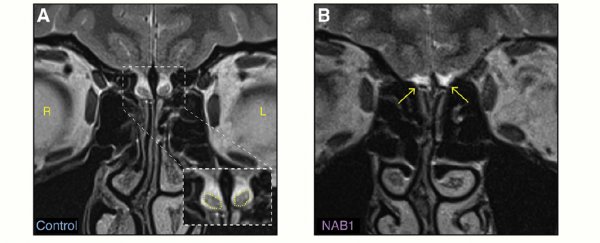Fresh-baked bread. Rain falling onto warm soil. Cut grass in the summer. We can relish in these fragrances thanks to a bundle of nerves deep inside each nostril called an olfactory bulb - or so we thought, anyway.
Among brain scans from over 1,000 subjects, researchers have now identified a handful of cases where individuals appear to lack this structure. Nevertheless, these people can identify smells surprisingly well.
Neurologists from the Weizmann Institute of Science in Israel and the Florey Institute of Neuroscience and Mental Health in Australia initially stumbled across two strange cases of missing olfactory bulbs while reviewing MRIs for a different study.
Since their research required left-handed female volunteers with a sense of smell, the absences stood out as particularly odd, warranting further investigation.
The olfactory bulbs, located deep inside most of our skulls, could be described as a pair of upside-down toothbrushes. Their handles reach back into our brain, and their bristles poke into the roof of our nasal cavities.
The purpose of this bulb of sensory nerves is to catch volatile particles floating about in the air we inhale and send messages into various parts of the brain, including sections responsible for memory and emotion.
The result can fill us with pleasure or disgust, summoning memories of fear or recollection of grandma's hugs. If this is the olfactory bulb's function, it stands to reason that should it be damaged – or missing altogether – our ability to detect any trace of a scent should be seriously affected.
Yet controversial studies on rodents raise some interesting questions. Even when olfactory bulbs have been eaten away by lesions, or removed altogether, researchers have found their lab animals could still respond to scent-oriented tasks.
Unfortunately, lab animals are crafty subjects, who might find ways to navigate that test for a tasty treat – smell or no smell. That leaves plenty of room for doubt over whether such results should be taken seriously
Having now stumbled across two volunteers who had no olfactory bulbs and still seemed to have a sense of smell, neurologists had an opportunity.
In spite of what you might think, we humans are pretty good smellers, discriminating between maybe as many as a trillion different odours. And, unlike rats, people can be quizzed on their experiences.
So the research team used their unexpected finds as a starting point to hunt down more examples in a massive public collection of MRIs aimed at mapping connections in the human brain.
Sifting through 1,113 scans, they uncovered a further three.
"A pleasant surprise was then finding this in the Human Connectome Project," says neurobiologist Noam Sobel from the Weizmann Institute of Science.
"Replication within a publicly available dataset adds a lot of credibility to the finding. This is not just some oddity that shows up only in our hands."
The new examples were also all women, with one also being left-handed. It's not at all clear what these biases mean, but the fact that the records all reported they had a sense of smell was startling.
To confirm suspicions, the team went back to their original two volunteers and recruited a third woman who lacked olfactory bulbs but also happened to have anosmia – an inability to detect scents.
More detailed scans of the volunteers' brains found their entire olfactory bulb structures were indeed diminished. The team concluded that they had to be tiny, if the women had any olfactory bulbs at all.
They then gave the women a whiff of 10 odorants and asked them to rate them according to 11 different descriptors. Their results were compared with those taken from 140 other women who all had completely functional olfactory bulbs.
The results provided by the two bulb-less women who could still smell were remarkable, but only in that they shouldn't have the ability to smell at all.
There was one other curiosity. The descriptors they each provided were eerily similar to one another's.
It's hard to tell exactly what's going on, and what – if any – olfactory nerves these women might have retained. But it does reinforce the notion that our brains are capable of doing a lot with very little.
"The simplest interpretation of our findings is that these women were born without an olfactory bulb, but thanks to the extreme plasticity of the developing brain, they developed an alternative glomeruli map somewhere else in the brain, not in the olfactory bulb," says Sobel.
This research was published in Neuron.
